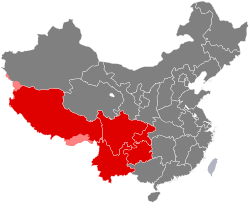Southwestern China
Southwestern China | |
|---|---|
 Government-defined region of Southwest China(including Chongqing, Sichuan, Guizhou, Yunnan, and Tibet)
(Red): Controlled by China ;(Light red): Disputed territory | |
| Country | |
| Area | |
| • Total | 2,365,900 km2 (913,500 sq mi) |
| Population | 192,979,243 |
| • Density | 82/km2 (210/sq mi) |
| GDP | 2022[2] |
| - Total | ¥13.713 trillion $2.039 trillion |
| - Per Capita | ¥71,060 $10,565 |
Southwestern China (
Geography
Southwestern China is a rugged and mountainous region, transitioning between the
The narrowest concept of Southwestern China consists of
History
Portions of Southwestern China, including the land that is modern day Yunnan, Guizhou, and Sichuan, were incorporated into China in 230 BCE by
In the 18th century CE, control of the Tibet Plateau area was important in the Great Game confrontations between the imperial powers of Russia, Britain, and China.[5]
After the warlord governments of China's Republican era replaced the Qing dynasty, government policy towards the southwest largely became one of inaction.[6]
The Second Sino-Japanese War prompted the Nationalist government to focus increasingly on state-building tasks in the southwest.[6] The city of Chongqing served as the capital of Chinese resistance to imperial Japanese expansion.
Western strategies to contain China in the 20th century CE included intervention in the Tibet plateau until almost the mid-1970s.
During the reform and opening up era, China began to look more seriously towards integrating its southwest regions.[7] China's increased focus on trade-led development and its transition to a socialist market economy helped trigger a reorientation to the southwest as its lagging development became increasingly seen as an impediment to growth.[8] China's southwest development initiatives reflect an awareness that economic engagement is the most cost-effective way to decrease political unrest and remedy underdevelopment along this frontier.[9]
Demographics
The diverse areas of Southwestern China carry strong regional identities and have been historically considered more rural than the more developed eastern regions of China.[4] Rapid development since the late 1970s has helped transform many parts of the region with modern advancements. In the early 21st century, Southwestern China contained 50% of the country's ethnic minority population which, in turn, formed 37% of the region's population.[4] Han Chinese migration has been largely concentrated in the urban centres, while the rural areas are still predominantly made up of minority populations, including the Zhuang, Miao, Yi, and others.
Inhabitants of Southwestern China primarily speak a dialect of
Administrative divisions
GB[11]
|
ISO №[12] | Province | Chinese Name | Capital | Population | Density | Area | Abbreviation/Symbol | |
|---|---|---|---|---|---|---|---|---|---|
| Yú | 50 | Chongqing Municipality | 重庆市 Chóngqìng Shì |
Chongqing | 28,846,170 | 350.50 | 82,300 | CQ | 渝 |
| Chuān (Shǔ) | 51 | Sichuan Province | 四川省 Sìchuān Shěng |
Chengdu | 80,418,200 | 165.81 | 485,000 | SC | 川(蜀) |
| Guì (Qián) | 52 | Guizhou Province | 贵州省 Gùizhōu Shěng |
Guiyang | 34,746,468 | 197.42 | 176,000 | GZ | 贵(黔) |
| Yún (Diān) | 53 | Yunnan Province | 云南省 Yúnnán Shěng |
Kunming | 45,966,239 | 116.67 | 394,000 | YN | 云(滇) |
| Zàng | 54 | Tibet Autonomous Region Xizang Autonomous Region |
西藏自治区 Xīzàng Zìzhìqū |
Lhasa
|
3,002,166 | 2.44 | 1,228,400 | XZ | 藏 |
Cities with urban area over one million in population
| # | City | Urban area[13] | District area[13] | City proper[13] | Prov. | Census date |
|---|---|---|---|---|---|---|
| 1 | Chongqing[a] | 8,894,757 | 12,084,385 | 16,044,027 | CQ | 2010-11-01 |
| 2 | Chengdu | 6,316,922 | 7,415,590 | 14,047,625 | SC | 2010-11-01 |
| 3 | Kunming[b] | 3,140,777 | 3,272,586 | 6,432,209 | YN | 2010-11-01 |
| 4 | Guiyang | 2,520,061 | 3,034,750 | 4,322,611 | GZ | 2010-11-01 |
- Notes
References
- ^ "Main Data of the Seventh National Population Census". National Bureau of Statistics of China. Archived from the original on May 11, 2021.
- ^ GDP-2022 is a preliminary data "Home - Regional - Quarterly by Province" (Press release). China NBS.
- ISBN 9787503141782.
- ^ ISBN 978-1741041859.
- ^ OCLC 939553543.
- ^ OCLC 939553543.
- OCLC 939553543.
- OCLC 939553543.
- OCLC 939553543.
- ^ Chinese Academy of Social Sciences (2012). Zhōngguó yǔyán dìtú jí (dì 2 bǎn): Hànyǔ fāngyán juǎn 中国语言地图集(第2版):汉语方言卷 [Language Atlas of China (2nd edition): Chinese dialect volume] (in Chinese). Beijing: The Commercial Press. p. 3.
- ^ GB/T 2260 codes for the provinces of China
- ^ ISO 3166-2:CN (ISO 3166-2 codes for the provinces of China)
- ^ ISBN 978-7-5037-6659-6.
